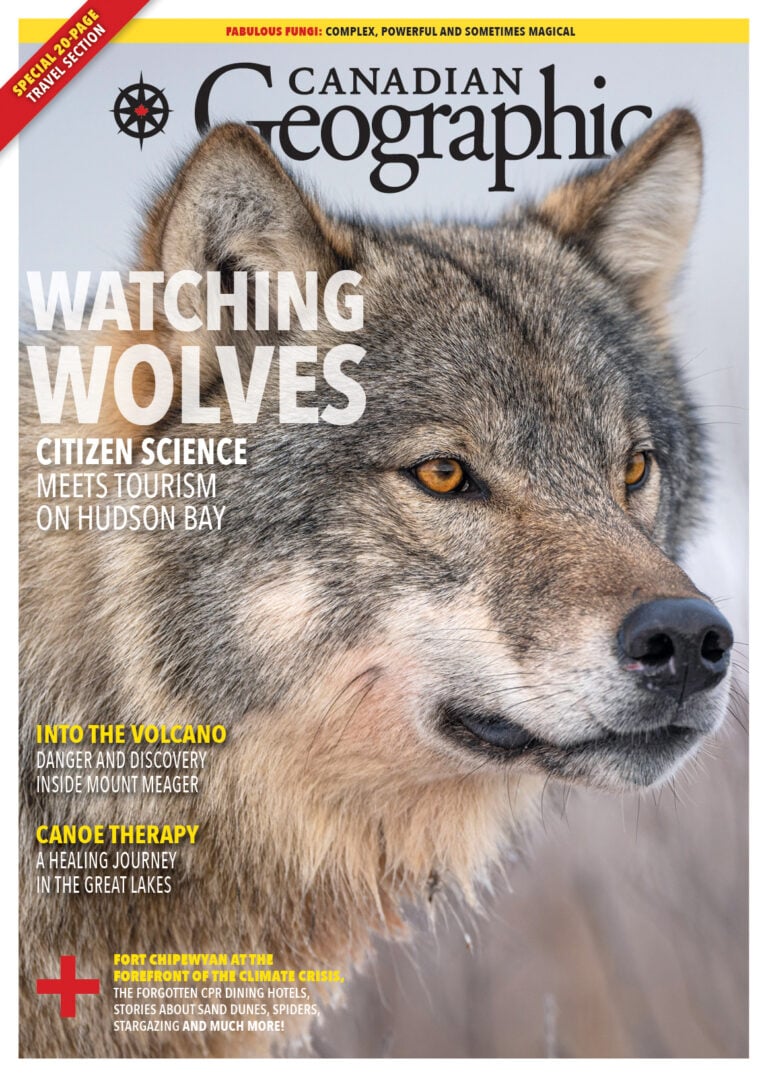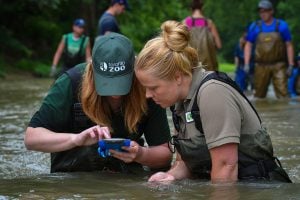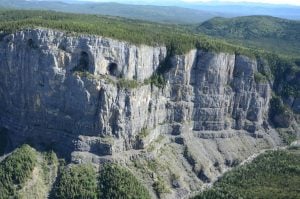
People & Culture
Renaming places: how Canada is reexamining the map
The history behind the Dundas name change and how Canadians are reckoning with place name changes across the country — from streets to provinces
- 4574 words
- 19 minutes
Science & Tech
As fungi bloom into the mainstream, a research station hidden in the B.C. Rainforest aims to uncover some of the mysteries of mushrooms

Branden Walle balances across a moss-covered cedar, long since fallen and now home to a miniature forest of hemlock seedlings and countless other unseen organisms. Sunlight flickers through the rainforest canopy. Gentle waves lap the nearby beach of Kapoose Creek, where a half-hour earlier Walle followed fresh wolf prints in sand still damp from an early morning outgoing tide.
“Let’s go climb that bank. I haven’t explored there yet,” says Walle, director of biology at Kapoose Creek, a secluded research station on the remote west coast of Vancouver Island that is emblematic of a growing worldwide fascination with all things fungi. There’s potential magic in the profusion of mushrooms here. Kapoose Creek is dedicated to unlocking some of this magic and finding new natural drug compounds derived from fungi.
To forage for fungi is to enter a still largely unexplored world of wonders. The hunt never gets old for Walle.

Growing up in Victoria, Walle spent many autumn days hunting with his dad and foraging for wild mushrooms in the Sooke Hills and elsewhere on southern Vancouver Island. They mostly sought common tasty varieties like pines and chanterelles. Those youthful forays sparked a passion for mushrooms that stayed with Walle through his university years and beyond. After ditching post-graduate studies in biochemistry, he continued foraging. He also learned to cultivate mushrooms.
“I started by using my bathroom as a fruiting chamber and an instant pot to sterilize substrate,” he says, laughing.
What began as a hobby led to him launching a small commercial operation, growing edible species with good shelf life and high commercial value like lion’s mane, oyster and shiitake mushrooms. In doing so, he became connected to a network of fungiphiles as wide-ranging as mycelium, the root-like structure of fungi that spread throughout the subterranean world in massive colonies.
“Look — a morel,” he says after crossing the log and clawing his way up the bank. “They love disturbed sites like this.” He points out how soil has sloughed down the bank.
He carefully picks the specimen, quietly murmuring this delicious edible’s scientific name, Morchella esculenta. Then he deposits the mushroom in a compartmentalized plastic tool kit, along with a half dozen other samples. In his right pocket are two vials, one containing a hairy lump of wolf scat and the other some fresh black bear scat.
Fungi grow almost everywhere — in soil, in trees, on the frigid Antarctic Peninsula, under our toenails and, yes, especially in feces. Spend a half-hour in the forest with someone like Walle, and you’ll start to regard the mucky ground beneath your feet with new reverence.

Fungi have puzzled taxonomists for years. They seem to elegantly straddle the worlds of plants and animals. Morphologically they appear like plants yet don’t produce food through photosynthesis the way plants do. On a cellular level, they are more animal than plant. Scientists believe the fungi kingdom contains between two million and five million species, yet only about 150,000 species have so far been formally discovered and described.
They are all around us, changing and manipulating life on Earth. Creating and destroying. They are powerful alchemists, turning rock to soil, recycling carbon, and activating nitrogen, phosphorous and other elements. Every day, doctors prescribe medications derived from fungi. Humans have been eating mushrooms and using yeast fungi for thousands of years to ferment food and drink.
Recently, researchers at the University of Sydney found that the saprotrophic fungi Aspergillus terreus can literally eat and break down poly-propylene, a discovery that could be a powerful new tool in the fight against plastic pollution. Entrepreneurs are harvesting mycelium to make non-toxic, waterproof and fire-resistant fabrics. Interestingly, this modern innovation builds on traditional Indigenous knowledge. Two textiles believed to be made from fungal mats are part of the collections at the Hood Museum of Art at Dartmouth College in New Hampshire and the Oakland Museum of California. Research by University of Victoria ethnobotanist Nancy Turner documents traditional uses of at least 40 species of fungi in Canada for a wide variety of purposes. For example, the Nlakla’pamux people of B.C.’s southern interior have long used a corky species of bracket fungus that grows on cottonwood trees to dye buckskin.

The diversity and abundance of fungal life below, on and above the ground is mind-boggling. There are the coprophilous fungi that grow on animal dung. Mycorrhizal fungi live in symbiosis with photosynthesizing plants. Some mycorrhizae produce fruiting bodies — mushrooms both delicious, like truffles that can fetch up to US$300 per ounce, and deadly poisonous, like the aptly named death cap. (Beware little brown mushrooms, warn foraging books.) Certain ascomycete fungi make their living by attacking and killing plants, responsible for such devastating maladies as Dutch elm disease.
North America has been called a fungiphobic culture, especially compared with Europe and parts of Asia where the tradition of wild mushroom foraging is deeply engrained. But that’s starting to change. The hunt for mushrooms in Canada is no longer the sole purview of a small, nerdy fringe; it’s gone mainstream.
“Mushrooms are definitely having their moment now,” Walle says.
The 2019 documentary Fantastic Fungi by American filmmaker Louie Schwartzberg brought the magical world of fungi to life through stunning time-lapse cinematography. Then the COVID-19 pandemic struck and propelled public fascination with fungi to another level, as more people got outside and explored their backyards. Online forums dedicated to mushroom identification and foraging suddenly lit up, connecting rookie foragers with citizen scientists like Melanie Hess, a Saanichton, B.C.-based massage therapist and mushroom geek.
Hess spends as much time on her volunteer role as president of the South Vancouver Island Mycological Society as she does at her day job. Her fungal fascination began a decade ago when, as an avid steelhead fisher and mountaineer, she began noticing brilliant yellow and orange things growing on the mossy Vancouver Island forest floor in the middle of winter. In a way, it was like treasure hiding in plain sight, she says, and it introduced her to a whole new way of observing nature that was addictive.
“Are the gills waxy? Is the stipe slimy? Is there an odour? And does the mushroom change colour after you pick it?” she explains. “It goes on and on.”

Beyond the joy that people like Hess and Walle get from their treasure hunts in the woods, collecting and studying fungi is important work that has led to many groundbreaking and even life-changing discoveries. Fungi produce a huge diversity of bioactive molecules, known as metabolites, that interact with other organisms in ways that are “spectacular,” says Kapoose Creek CEO Eric Brown, a biochemist and Canada Research Chair in microbial biology at McMaster University in Hamilton.
Take penicillin, for example. It was discovered by accident in 1928 by Alexander Fleming when he returned from a holiday to his lab at St Mary’s Hospital in London, England, and noticed mould growing on a petri dish of staphylococcus bacteria. The mould appeared to be preventing bacteria from growing around it. This simple but keen observation led to the discovery of an antibiotic derived from the fungus Penicillium notatum.
Blockbuster cholesterol-fighting statins, the antibiotic cephalosporin, the migraine medication ergotamine, and the antifungal drug caspofungin all come from fungi. So does cyclosporine, an immunosuppressive drug derived from the fungus Tolypocladium inflatum and used worldwide to prevent organ transplant rejection.
“If you knew what I know about the way cyclosporine interacts with targets inside a cell, it would blow your mind,” Brown says over the phone from his lab in Hamilton. “There’s no way a chemist could dream this up in a synthetic laboratory environment.”

In recent years, there’s been a resurgence of interest among health care professionals in psilocybin, a psychoactive chemical compound found in more than 200 species of so-called magic mushrooms, as a prescription for the treatment of depression, anxiety and other mental health disorders. (The production, sale and possession of psilocybin has been prohibited in Canada since 1974 when it was declared a controlled substance under the Food and Drugs Act, though the federal government now makes exceptions for clinical trials and special treatment.)
Following a morning of collecting samples, Walle returns to the research station with his trainers full of pine needles, moss and other forest floor detritus. He trades his outdoor gear for a white coat, opens the coded door to the lab, spotless and gleaming with stainless steel equipment, then cracks open his kit to look at the morning’s harvest.
Walle begins working beneath a laminar flow cabinet to prevent contamination, mostly from the airborne microscopic spores of common indoor moulds. He removes the first sample, a thumb-sized morel, and spins it for a minute in a solution of sterilizing bleach.
Then, with the precision of a surgeon, he uses a scalpel to excise a tiny slice of tissue, which he submerges
in a growth medium of agar set on a petri dish. He pauses to stretch his back, cramped from hunching over the lab table, then goes back to work on the next specimen, one he has yet to identify conclusively.
In a few weeks, when the cultures have grown, the tissue will be freeze-dried into a powdery substance. Then, using a device called an accelerated solvent extractor, the biochemist’s version of an espresso machine, Walle will pump high-pressure, high-temperature solvent through the dried fungal tissue. Finally, this cocktail of chemicals will be broken down into its constituent chemical compounds, or metabolites, using a technique called reversed-phase liquid chromatography.
To forage for fungi is to enter a still largely unexplored world of wonders.
But this is just the beginning. Next, carefully labelled samples will be shipped across the country to McMaster University, where Brown and his team will take an even deeper analytical dive to try to answer the million-dollar questions: what are these specific metabolites, what do they do, and could they have medical applications?
Kapoose Creek is focused on three broad areas of medical treatment: infectious disease, cancer and neurological disorders such as Parkinson’s and Alzheimer’s disease. The potential for fungi to advance the field of neurology is particularly exciting. The way some species communicate with other organisms is nothing short of miraculous — “and it all involves neurochemistry,” says Brown.
For example, fungi of the family Ophiocordycipitaceae, commonly known as zombie-ant fungus, infect ants with a pathogen that hijacks the insect’s nervous system to serve their own reproductive needs. The fungus alters the behaviour of the ant, causing it to attach by the mandibles to a plant leaf or stem until it dies. During that time, fruiting bodies grow from the ant’s head, eventually rupturing to release fungal spores. It’s an almost unbelievable, phantasmagorical relationship that could have been conjured from the mind of Stephen King.

Artificial intelligence-powered technology is enabling researchers to plumb the depths of this complex biochemical world. At Brown’s lab, they’re conducting two tests. The first examines how metabolites interact with human cells in culture. The second looks at whether and how they influence animal behaviour. For a test subject, Brown is using the lowly roundworm. Just a millimetre long, this organism has a nervous system remarkably similar to that of humans. By recording the movements of these worms, researchers can identify neurochemical effects, or how mushroom-derived chemical compounds influence worm behaviour. AI algorithms produce what Brown calls “activity maps” from these two tests that allow him to size up the therapeutic potential of these metabolites.
“Fungi are propelled by millions of years of interspecies evolution to create certain chemicals. We don’t know what they’ll be useful for. We just know they’re not created by accident. Nature doesn’t make mistakes,” Brown says.
Academic interest in fungi is fruiting else where in Canada and on many fronts. In 2019, scientists formed the Canadian Fungal Network to promote collaboration and dialogue among experts working in the field.
And there are many. For example, University of Toronto botanist James Scott heads up the UAMH Centre for Global Microfungal Biodiversity, one of the world’s largest living collections of environmentally and medically important microfungi. Linda Harris, a research scientist with Agriculture and Agri-Food Canada, is studying how the deadly fungal pathogen Fusarium graminearum infects cereal crops. And Justine Karst at the University of Alberta is studying the critical role mycorrhizal fungi play in forest ecology and recovery. These are just a few of the people exploring the powerful, sometimes mysterious ways that fungi shape life around us.

Another sunny morning and another opportunity for Branden Walle to scour the woods for fungi. This time, he’s focusing his attention on the marshy wetlands and stunted bog forest that wraps around the lower reach of Kapoose Creek. A bald eagle perches on a snag above the creek, regally observing the proceedings. Nearby, a black bear grazes on riparian sedges, unperturbed by the presence of humans. Walle keeps a respectful distance.
So far, 30 per cent of the 5,000 fungi samples in Kapoose Creek’s ever-growing collection have “no known match in the public domain. They’re mysterious,” Brown says.
Somewhere out there on this biological frontier, locked in the complex biochemistry of one these mysterious fungi, the next blockbuster, life-changing drug awaits discovery.
As Walle wades through head-high salal bushes, it feels like searching for a needle in the proverbial haystack. But that’s what makes the hunt so alluring. “We’re just trying to look under stones that have never been looked under.”
Are you passionate about Canadian geography?
You can support Canadian Geographic in 3 ways:

This story is from the September/October 2023 Issue

People & Culture
The history behind the Dundas name change and how Canadians are reckoning with place name changes across the country — from streets to provinces

Environment
A new study finds zoos and aquariums in Canada are publishing more peer-reviewed research, but there is still more to be done

Environment
The fun guy behind the mushroom hunt that became North America’s largest fungi bioblitz

Exploration
2022 is the International Year of Caves and Karst. Here’s why you should care about the hidden worlds beneath our feet.